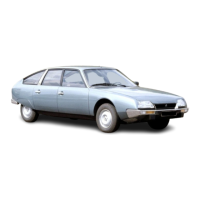`.'
R°.'
0..
..a
0
0 Ort
.-i
Oms»,
Q°<
n-.
.-i
ö..
"l7
0..
tfn
.5'
(D,
t7-
q..
q'.
fl.
.17
t/7
.-C
..,
.1]
.v.
cal
Cl.
i..
O.,
.1a
t11
t/1
--.
.-O
i-.
C-.
-c:
t+1
.sa
.Ja
p.,
4 OPERATION
N° MÅ
142-00 SD
:
(/'ara/(ri
/jCS (1/1(1
'/)((/ll/
/((li//?(
()
t
//( (/0
f/
/c
(
llJ/)jS//
\lt/'k/:
1
U!I(
lI:,S
)
II.
CX
2000
T1e object
of
the
system
is
to reduce
the amount
of
unburnt hydrocarbons
and
the
amount of CO in
the
exhaust
approximately
2 to
3
of
CO
)
by inecting
air under
pressure
into
the exhoust monifold
OPERATION:
As
the engine rotates
air pump (12)
supplies the air injectors
located
near the exhaust valves: flap
(13
prevents the exhaust fumes from
entering the air pump and air
supply duct
assembly.
There
are twa cases
where
it
is
necessary to stop
the
injection
af air
into
the exhaust
manifold.
During
deceleration
Durinq
fast deceleration,
the mixture
becames richer,
combustion
is incomplete. and
the
injection
of
air
is
stopped in order to
avoid
a
second
combust ian
takinq
place in
the
exhaust
system
(
which
would result in
back-firing
)
Durinq
deceleration,
there
is
extreme low
pressure
downstream
of the butterfly
(1
).
This
in
tum
draws
in
for
a
short
period of time
the diaphragm
in valve
(11)
The
air
supplied by
pump (12)
is
released
inta
the
atmasphere,
the calibrated hole
«
a on
the
diaphraqm
balunces
the pressure on either side of it,
and the diaphragm
returns
to its initial
position,
allowinq air to
be
once mare injected
inta
the exhaust
manifald
2.
With
the
choke
out, for an engine
coolant
temperature of above
450
±
30
C,
and whenever the coolant
tempe-
rature
remains above
350
J
C.
In this
situation,
the
quantities of unburnt hydracarbons
and
CO
are
very
considerable It is
therefore
necessary
to stop
the injection of
air
into
the exhaust manifold sa
as
to
avoid any
excessive increase of
temperature in
the monifold.
On
CX 2000 vehicles, injection
of air will
be stopped
when the enqine
water temperature reaches
45
±
3
C
Thermal
switch
(8) opens
relay (9) is no longer
energized. but electrovalve
(7)
remains
live
relay lead
).
and is earthed via
the chake contral
The
air pressure at
the
outlet of
air-pump (12
)
increases
the
effect of the low
pressure an the diaphragm
in
valve (11)
(the
air
pressure
is
felt above the diaphragm,
and
the
law
pressure
produced by
the
carburettor
(2)
is
felt below
the
diaphragm
).
the slidinq
valve in the
duct changes position,
and the air is
expelled
inta
the
atmosphere
If
the choke (10) is
pushed
back in air is
once again injected
into the
exhaust manifold
DEVICE FOR OPENING
THE
BUTTERFLY:
The
object
of
the
device is ta
maintain combustion
during sudden
decelerotion up to an
enqine
speed
af
Nd 1800 ± 100 rpm.
Durinq deceleration for any
enqine speed above
Nd, the electronic
tachometer housinq (6)
earths the
windinq
of relay
(5) Therefore
the
« PIERBURG
»
electra-valve
(4)
is
no
longer
energized Electro-
valve
(4)
is
then under low-pressure,
below
the
diaphragm
of the device
(3)far opening
the butterfly
When the decreas ing
engine speed falls
below Nd, the electronic tachometer hous ing (6)
cuts
out
the
earth of
the
winding
in
relay (5) Therefore
the
« PIERBURG »
electro-valve
(4)
is energized
The
electrovalve is
no longer under low pressure
belaw the diaphraqm of
the
device (3)
for opening
the
butterfiy
the
throttle
butterfly returns
to its stop against
the
idling
speed
adjustment screw.
The
dia
phragm of
the device
(3)
for openinq
the butterfly
will
once again
be
affected
by
low
pressure
(
under
the control of
the electronic tachometer
housing
)
ance the
incréasing
engine speed reaches
Nc Nd f
50
to
250 rpm
NOT E
:
/
f 0H/1/
o
sI, o 0(15 ((ro
or,
rio
cl for Co
Cm
bi oj 1 Iom/) orO/ii
ro io
bo
tho Oh 2O'
(.
a;uf +
-,O'
(.
(/11(1
(1
/'Ol/1itO
lii bOIhl'OOJ/
12
(1/1(1
15 lo/Is.
PDF compression, OCR, web-optimization with CVISION's PdfCompressor

